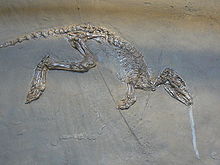You can help expand this article with text translated from the corresponding article in Italian. (April 2019) Click [show] for important translation instructions.
|
| Leptictidans Temporal range: Late Cretaceous - Oligocene
Possible descendant taxon Placentalia survives to present | |
|---|---|

| |
| Fossil specimen of Leptictidium auderiense | |
| Scientific classification | |
| Domain: | Eukaryota |
| Kingdom: | Animalia |
| Phylum: | Chordata |
| Class: | Mammalia |
| Clade: | Eutheria |
| Order: | †Leptictida McKenna, 1975 |
| Subgroups[1] | |
Leptictida (leptos iktis "small/slender weasel") is a possibly paraphyletic extinct order of eutherian mammals. Their classification is contentious: according to cladistic studies, they may be (distantly) related to Euarchontoglires (rodents, primates and their relatives), although they are more recently regarded as the first branch to split from basal eutherians.[2] One recent large-scale cladistic analysis of eutherian mammals favored lepictidans as close to the placental crown-clade;[3] and several other recent analyses that included data from Cretaceous non-eutherian mammals found Leptictis to belong to the superorder Afrotheria.[4]
The most recent phylogenetic studies recover it as actually a paraphyletic assemblage leading to Placentalia.[5]
- ^ Hooker, J. J.; O'Regan, H. (2013-07-15). "Origin and evolution of the Pseudorhyncocyonidae, a European Paleogene family of insectivorous placental mammals". Palaeontology. 56 (4): 807–835. Bibcode:2013Palgy..56..807H. doi:10.1111/pala.12018.
- ^ Zack, S. P.; Penkrot, T. A.; Bloch, J. I.; Rose, K. D. (March 2005). "Affinities of 'Hyopsodontids' to elephant shrews and a Holarctic origin of Afrotheria" (PDF). Nature. 434 (7032): 497–501. Bibcode:2005Natur.434..497Z. doi:10.1038/nature03351. PMID 15791254. S2CID 4428738.
- ^ Wible, J. R.; Rougier, G. W.; Novacek, M. J.; Asher, R. J. (September 2009). "The eutherian mammal Maelestes gobiensis from the Late Cretaceous of Mongolia and the phylogeny of Cretaceous Eutheria". Bulletin of the American Museum of Natural History. 2009 (327): 1–123. doi:10.1206/623.1. hdl:2246/6001. S2CID 86337881.
- ^ O'Leary, Maureen A.; Bloch, Jonathan I.; Flynn, John J.; et al. (8 February 2013). "The Placental Mammal Ancestor and the Post–K-Pg Radiation of Placentals". Science. 339 (6120): 662–667. Bibcode:2013Sci...339..662O. doi:10.1126/science.1229237. hdl:11336/7302. PMID 23393258. S2CID 206544776.
- ^ Halliday, Thomas J. D. (2015). "Resolving the relationships of Paleocene placental mammals" (PDF). Biological Reviews. 92 (1): 521–550. doi:10.1111/brv.12242. PMC 6849585. PMID 28075073.